 Most viewed - Yokohama 横浜市 Most viewed - Yokohama 横浜市 |

81 views
|
|

ミス サリバン81 views
|
|

Another juggling act was the Kikyo Brothers. 桔梗ブラザーズ Also see my video at YouTube. 桔梗ブラザーズ81 views
|
|

Another balloon act.81 views
|
|
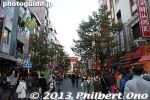
Walking toward Chinatown.81 views
|
|
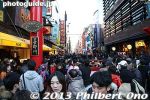
Yokohama Chinatown was jammed with people on Feb. 10, 2013, Chinese New Year. 81 views
|
|
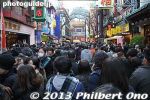
Dangerous for small kids and baby strollers.81 views
|
|

The lions jammed the streets with people wherever they went.81 views
|
|
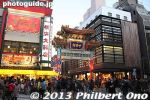
Yokohama Chinatown gate.81 views
|
|
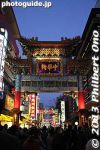
81 views
|
|
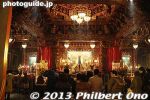
Inside Kwan Tai Temple.81 views
|
|
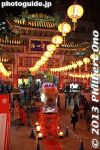
81 views
|
|
|
|

80 views
|
|

After making a grand entrance, they finally reached their performance area.80 views
|
|

Unfortunately, they didn't have a microphone so we couldn't hear them. おじゃるず80 views
|
|

Another act which I didn't have time to see: 3 Gaga Heads 3ガガヘッズ80 views
|
|

Diane Orrett gives a balloon headphone.80 views
|
|
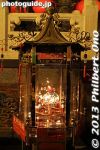
80 views
|
|
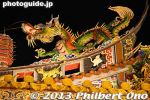
Ornate roof of Kwan Tai Temple.80 views
|
|

Lion bait.80 views
|
|
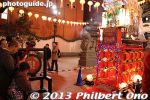
Pay a fee to ring the gong and walk through the palanquin for good luck.80 views
|
|
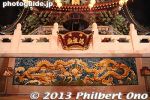
80 views
|
|
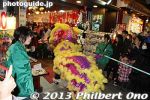
More lion dances.80 views
|
|

80 views
|
|

Yokohama Port was opened to the world in 1859, making 2009 the 150th anniversary of the port's opening. To celebrate, Yokohama held EXPO Y150 during April 28 to Sept. 27, 2009.79 views
|
|

A more recent electric car, no longer sold.79 views
|
|

79 views
|
|
|
|

79 views
|
|

It's impossible to see all the acts in one day. But I was able to see all the acts I really wanted to see, plus a few more.79 views
|
|

79 views
|
|

79 views
|
|
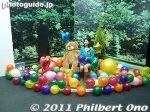
FujiFilm used this girl and set to demo their 3D camera.79 views
|
|

The lion danced for a few minutes in front of each shop or restaurant. They also went inside and danced. The first lion I saw was yellow.79 views
|
|
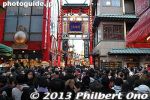
79 views
|
|
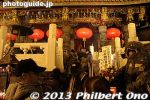
79 views
|
|
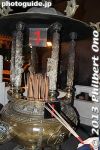
Incense burner at Kwan Tai Temple.79 views
|
|
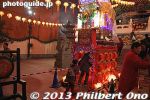
79 views
|
|
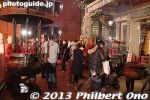
Incesne burner at Ma Zhu Miao Temple Masobyo.79 views
|
|
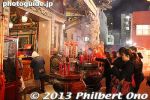
New Year's prayers at Ma Zhu Miao Temple Masobyo, Yokohama.79 views
|
|
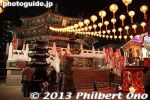
79 views
|
|

Hula dancers wait perform on the outdoor stage.78 views
|
|

Hajimari-no-Mori consisted of these round buildings.78 views
|
|

Map of the Bayside Area which consists of several expo places, three of which required admission. 78 views
|
|

Painting depicting Perry's landing at Yokohama.78 views
|
|

Pretty dramatic show.78 views
|
|

After a beautiful. high-definition film (included footage of hang gliding atop Hawaii's Diamond Head) in the Super Hi-Vision Theater, we come here to gaze at Nissan's prototype electric car.78 views
|
|

The Kanko Maru was on loan from Huis Ten Bosch in Nagasaki.78 views
|
|

Next activity was tying rope knots. Haven't done this since being a Boy Scout.78 views
|
|

Arrive back to port.78 views
|
|

78 views
|
|

Balloon Man バルーンおやじ78 views
|
|

This was in late April when the yaezakura was in bloom.78 views
|
|
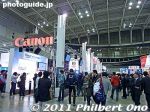
Canon booth in a central location.78 views
|
|
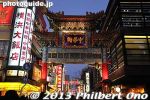
Yokohama Chinatown gate.78 views
|
|
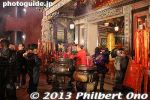
78 views
|
|
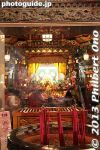
78 views
|
|

Bashamichi Station pointing the way to EXPO Y150. The expo has three areas, with the Bayside Area being the main one at the waterfront area next to the Red Brick Warehouses.77 views
|
|
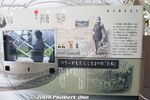
77 views
|
|

77 views
|
|

77 views
|
|

77 views
|
|

77 views
|
|

77 views
|
|

77 views
|
|

77 views
|
|

Plaque behind the statue.77 views
|
|
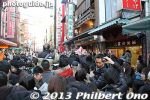
Crowd gathers wherever the lion is.77 views
|
|
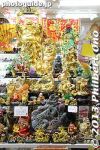
Auspicious, gleaming souvenirs.77 views
|
|

Lyrics to the Iwakuni Ondo "Nisei Soldiers" song about the 442nd RCT composed by Mune Ozaki.77 views
|
|

76 views
|
|

The dawn of Japan-America relations.76 views
|
|

History of Yokohama after the port opening in 1859.76 views
|
|

With many Western technologies brought to Yokohama, many of Japan's Western things like railroads, ice cream, photography, and publishing started in Yokohama.76 views
|
|

Beato Photo Studio. Beato was a pioneering photographer in Japan.76 views
|
|

Sometimes the spider would spew its web from its mouth and tail. (Actually water.)76 views
|
|

It crawls from one end to the other.76 views
|
|

Inside Dream Front in the waiting lobby were corrugated cardboard models of various boats. On the left is Hokule'a from Hawaii.76 views
|
|

Yamashita Park was as far as we got.76 views
|
|

76 views
|
|

Unfortunately, I had to answer my cell phone during this performance and couldn't shoot the rest of their act.76 views
|
|

Plaque in English 76 views
|
|
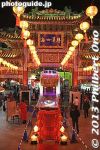
76 views
|
|
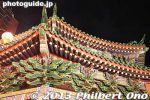
76 views
|
|
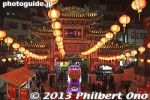
76 views
|
|
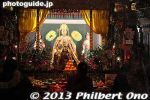
76 views
|
|
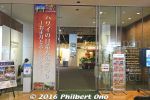
Museum entrance.76 views
|
|

Bayside Area's main venue is the Hajimari-no-Mori.75 views
|
|

Hajimari-no-Mori Gate. 75 views
|
|

Inside Hajimari-no-Mori. It's not a huge place, but the main attraction is La Machine and the Yokohama Monogatari Pavilion.75 views
|
|

The start of new occupations.75 views
|
|

75 views
|
|

Kanko Maru in Yokohama75 views
|
|

75 views
|
|

75 views
|
|

75 views
|
|
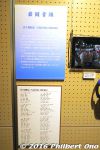
"Sakuma Teicho" lyrics.75 views
|
|

Ticket office at Hajimari-no-Mori. Admission for adults is 2400 yen.74 views
|
|

Inside the Yokohama Monogatari Pavilion which explains Yokohama's history with emphasis on Perry's visit.74 views
|
|

Entrance to the Hajimari-no-Mori's main pavilion called Yokohama Monogatari (Yokohama Story).74 views
|
|

74 views
|
|

74 views
|
|

Across the road from Hajimari-no-Mori is Tomorrow Park, a smaller site, mainly an indoor theater for anime. Admission required.74 views
|
|

Nissan's first electric car.74 views
|
|

Yokohama Bay Bridge.74 views
|
|

Red Brick Warehouses74 views
|
|

Off Minato Mirai74 views
|
|

Red Brick Warehouse had a restaurant and souvenir shop called "Open Country, Open Port." Free admission.74 views
|
|

Statue of Ii Naosuke and Landmark Tower in Yokohama.74 views
|
|

74 views
|
|

Entrance to Osambashi Pier in Yokohama. This is a terminal building and dock for large passenger ships. When there are no ships, the facility can be rented for various events.73 views
|
|
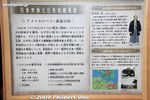
73 views
|
|

73 views
|
|

One new occupation was photographers.73 views
|
|

Each of the spider's legs is controlled by an operator.73 views
|
|

Inside ENEOS Energy Future Pavilion73 views
|
|

Kurofune Restaurant73 views
|
|

Futuristic Theater BATON showed anime movie.73 views
|
|

73 views
|
|

Now a ride on the Kanko Maru blackship. It was a free ride for Expo Y150 admission ticket holders. Reservation tickets were available from 10 am at the entrance of Tomorrow Park which is near the boat pier.73 views
|
|

73 views
|
|

Then we were allowed to walk along the bowsprit after donning life jackets. Safety net below, but we were told not to bring sunglasses, etc., which may fall into the water.73 views
|
|

Hajimari-no-Mori's main attraction is La Machine, a giant mechanical spider. (Photos below.)72 views
|
|
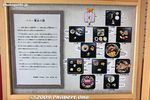
Food served to Perry and his men.72 views
|
|
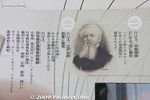
About Townsend Harris, US Counsel.72 views
|
|
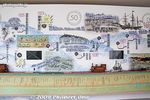
Panel outlining the history of Yokohama since its port opening.72 views
|
|

The start of newspaper publishing.72 views
|
|

Souvenir shop72 views
|
|

Tanemaru dolls72 views
|
|

Kurofune (Blackship) Restaurant72 views
|
|

72 views
|
|

72 views
|
|

72 views
|
|

72 views
|
|

72 views
|
|

Minato Mirai skyline72 views
|
|

Pukari Pier72 views
|
|

Japan Coast Guard ship72 views
|
|

72 views
|
|
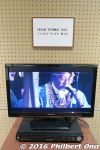
Video of James Kunichika singing an Iwakuni Ondo song called "Sakuma Teicho" about Tsutomu Sakuma, the brave commander who died when his submarine that sank off Yamaguchi Prefecture in 1910.72 views
|
|

Showcase had more exhibits about Iwakuni Ondo with an umbrella, happi coat, and tenugui hand towel from the Iwakuni Odori Aiko Kai.72 views
|
|

Hall Stage71 views
|
|

The outdoor stage was the best and roomiest facility for sitting down and watching the entertainment.71 views
|
|

71 views
|
|

71 views
|
|

Entrance to Tomorrow Park71 views
|
|

71 views
|
|

Kanko Maru departing the pier.71 views
|
|

First duty of the day was to raise the mast.71 views
|
|
|

71 views
|
|

Commemorative monument71 views
|
|

The back of the exhibition room was this large cloth panel listing all the places (mostly Buddhist temples) on each island that hold a bon dance.71 viewsUpper right photos are of Waialua Hongwanji on Oahu and lower left photos show Daifukuji Soto Mission in Kona.
|
|

C.I.Q Plaza stage where numerous hula troupes, etc., performed all day long.70 views
|
|

Clothing shops and the outdoor stage can be seen in the distance.70 views
|
|
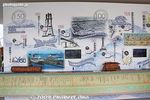
70 views
|
|
|

Entrance to Tomorrow Park70 views
|
|

Inside Tomorrow Park70 views
|
|

Futuristic Theater BATON70 views
|
|

70 views
|
|

70 views
|
|

70 views
|
|

70 views
|
|

Asuka II luxury ship was docked at Osanbashi.70 views
|
|

Osanbashi Pier.70 views
|
|

Tenugui hand towels often worn or used by bon dancers.70 views
|
|

Mini theater at the Yokohama Monogatari pavilion.69 views
|
|

69 views
|
|

69 views
|
|

69 views
|
|

69 views
|
|

69 views
|
|

The Kanko Maru was built in 1987 in Holland.69 views
|
|

69 views
|
|

69 views
|
|

69 views
|
|

69 views
|
|

69 views
|
|

69 views
|
|

69 views
|
|

Safety net below so it was not dangerous to walk on the pole.69 views
|
|

Places on Kauai that hold a bon dance.69 views
|
|

The multi-level Osambashi Pier building is huge and goes beyond what your eye can see. The air-conditioning was quite high, making all of us sweat.68 views
|
|

Bruce Shimabukuro (Jake's brother) gives a ukulele workshop.68 views
|
|

Earth Balloon HOME. Lit up at night and floats up by 20 meters.68 views
|
|

Stage68 views
|
|

Stage68 views
|
|

The third Bayside Area venue was at Shinko Pier, featuring Nissan Dream Front. The building looks like a large warehouse. It had exhibits and a theater.68 views
|
|

68 views
|
|

68 views
|
|

On top deck.68 views
|
|

68 views
|
|

Below deck on the Kanko Maru. This deck was air-conditioned.68 views
|
|

Raising a sail.68 views
|
|

Bon Dance Panel 8 - Iwakuni Ondo Aiko Kai and James Kunichika68 viewsIn the 1920s, an Iwakuni Ondo group was formed. They obtained a taiko drum and other implements and started practicing for public performances. Such a group played an important part in having the Iwakuni Ondo survive in Hawai’i.
In 1951, popular Honolulu bon dance singer James Kunichika (1915–2012) formed the Iwakuni Odori Aiko Kai fan club together with taiko drummer Goichi Fukunaga. (Kunichika was born on Kauai and moved to Honolulu. Iwakuni was his mother's hometown.) At the time, it was Oahu's only official fan club for the Iwakuni Ondo. It was composed only of Yamaguchi Prefecture immigrant descendants. From the 1980s, their membership increased dramatically. By 2000, they had over 200 members. The Honolulu mayor and Lieutenant Governor at the time were also members.
The Iwakuni Ondo's lead singer has to memorize long Japanese lyrics lasting 10 to 15 min. So it was important to train the younger generations. By the mid-1990s, Japanese-speaking nikkei in Hawai’i were almost gone and Kunichika was practically the only bon dance lead singer on Oahu who could sing in Japanese.
Kunichika made efforts to train the non-Japanese-speaking sansei as successor singers. He also worked hard to perpetuate and sustain the Iwakuni Ondo on the neighbor islands.
For his efforts and accomplishments, he received numerous awards including the Living Treasure Award from the Honpa Hongwanji Mission of Hawai’i and the 2003 Pan-Pacific Festival Silversword Award.
Panel photos: Top is Iwakuni Ondo Aikokai soon after it was formed. Bottom is Kunichika (second from left) at home teaching Iwakuni Ondo to a few younger people.
|
|

This is what it looks like outside the Osambashi Pier. In the distance is Yamashita Park. It was here where King David Kalakaua arrived in Japan during his world tour in 1881. This fact serves as the basis for the existence of this festival.67 views
|
|

67 views
|
|

67 views
|
|

Bon Dance Panel 6 - Bon Dance Songs Still in Use67 viewsThe songs played at bon dances in Hawai’i are either recordings from CDs or tapes or performed live. Recordings include modern ondo songs like Tanko-bushi and Pokemon Ondo. New recorded songs are also added every year. Songs performed live have a deep connection to the specific prefecture from where immigrants hail.
In 1924 when Japanese immigration was banned, the Japanese population in Hawai’i was 125,361. Most of them came from (in order of the highest number): 1. Hiroshima, 2. Yamaguchi, 3. Kumamoto, 4. Okinawa, 5. Fukuoka, 6. Niigata, 7. Fukushima, and 8. Wakayama. Of the five prefecture-specific bon dance songs that were performed in Hawai’i until the postwar years, only three of them have survived: Iwakuni Ondo (from Yamaguchi), Fukushima Ondo (from Fukushima), and Eisa (from Okinawa).
Table shows the number of immigrants from each prefecture and their percentage in the Japanese population in Hawai’i (same order as listed above from 1 to 8). Right column shows the five prefecture-specific bon dance music genres that they practiced.
Panel photo shows Eisa drummers at the Okinawan Festival at Kapiolani Park in Honolulu in 2013.
|
|

Places on Oahu that hold a bon dance.67 views
|
|
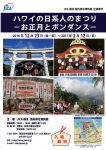
Museum's exhibition flyer.67 views
|
|
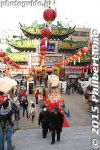
67 views
|
|

Food stalls serving Hawaiian-like food.66 views
|
|

Clothing stall66 views
|
|

The Hokule'a visited Yokohama from Hawaii in 2007.66 views
|
|

Bon Dance Panel 4 - From Bon Odori to Bon Dance66 viewsIn the 1950s, Hawai’i's Japanese community shifted from the issei to the nisei and the "bon odori" began transforming into a Hawai’i-style "bon dance."
Bon dances got infused with new songs based on Hawai’i's lifestyle and Hawai’i-themed songs composed in Japan. The old "Hole-hole-bushi" song sung by Japanese laborers in the sugar plantations got a new version composed by Japanese composer Raymond Hattori in 1957 at Columbia Records in Japan. In the 1960s, Buddhist bon dance songs like Bukkyo Odori, Daishi Ondo, and Shinran Ondo were also introduced. Likely due to the bon dance's strong connection with Buddhist temples. ("Bukkyo" means Buddhism, "Daishi" is an honorific title for a Buddhist sect's founder, and "Shinran" is the name of the founder of the Jodo Shinshu Sect.)
Even today, the bon dance is the largest social gathering of nikkei in Hawai’i. Even without understanding the Japanese language, young and old alike can dance to Japanese songs and enjoy the bon dance. Originally, the bon odori was for the Japanese to reaffirm their Japanese identity. After the war, it has become an event reflecting Hawai’i's melting pot. Today, we often see people from other ethnicities enjoying the bon dance.
Panel photos: Top photo is a bon dance food stand at Kona Hongwanji on the Big Island. Bottom photo is a bon dance at Lahaina Jodo Mission on Maui showing non-nikkei dancers.
|
|

Bon Dance Panel 7 - Iwakuni Ondo, a Case Study66 viewsOf the many bon dance songs used in Hawai’i, there are songs that remained while others disappeared over the years as the times changed. What were the factors that caused the songs to remain or disappear?
Iwakuni Ondo is one of the three bon dance music genres that remain in Hawai’i. It is performed live with the singer on the yagura tower holding up an umbrella and singing a song having seven-and-five syllables. Many of the songs expressed the passionate emotions of the Japanese people. The songs included Japanese historical episodes and war stories such as Nikudan Sanyushi (Three Human Bullets 肉弾三勇士, about three heroic Japanese soldiers who sacrificed themselves while blowing up enemy lines in Shanghai in 1932) or Sakuma Taii Monogatari (Sakuma Teicho 佐久間艇長 or 佐久間大尉物語 about Tsutomu Sakuma, the brave commander who died when his submarine that sank off Yamaguchi Prefecture in 1910). Such songs are still popular in Hawai’i today and the yonsei and gosei have learned the story even if they don't understand Japanese. A taiko drummer at the bottom of the yagura accompanies the singer and sets the beat. The dancers dance clockwise, spinning their arms elegantly.
Most immigrants from Yamaguchi Prefecture came from specific regions so they had a strong hometown affinity among themselves. From the early 1900s, they formed hometown associations according to their village or town. These associations were later unified by the Yamaguchi Prefecture Kenjinkai Association formed in 1926. To reinforce their hometown unity, they held picnics, movie screenings, concerts, stage performances, and bon dances.
After the war, new Iwakuni Ondo songs were created. They were about Hawai’i. One song called "Nisei Soldiers" (ああ第442部隊) was about the 442nd RCT composed by Mune Ozaki to memorialize them. This song was often sung during the nisei's heyday in Hawai’i.
Panel photos: Top is James Kunichika singing Iwakuni Ondo on the yagura at a bon dance in 2001. Bottom photo is dancers dancing to the Iwakuni Ondo at a bon dance.
|
|

Places on Maui that hold a bon dance.66 views
|
|

First you see this small Welcome stage where keiki hula and other performances were held.65 views
|
|

Even shave ice.64 views
|
|

Aloha shirt for 100th Infantry Battalion veterans with a Japanese and Hawaiian design. The design includes torii, Japanese castle, shamisen, pagoda, pineapple, Gion Matsuri float, and "One Puka Puka" (100).64 viewsBelow are military medals, badges, and patches.
|
|
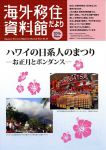
Cover of the museum's newsletter (Winter 2016 issue) publicizing the "Hawai’i's Nikkeijin Matsuri—Oshogatsu and Bon Dance" exhibition.64 views
|
|
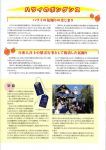
Page 3 gives a history of bon dance in Hawai’i. Lower part explains New Year's worship at Shinto shrines in Hawai’i.64 views
|
|
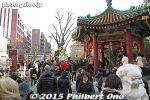
64 views
|
|
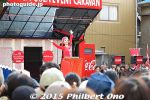
64 views
|
|
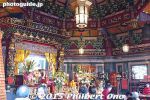
Inside Yokohama Ma Zhu Miao Temple (Masobyo in Japanese 横浜媽祖廟)64 views
|
|

Another stage was in the C.I.Q Plaza. Standing room only.63 views
|
|

At one end was the Hall Stage where more people entertained.63 views
|
|

Upper left shows a Hawai’i Hochi newspaper (April 2, 1943 issue) with Japanese announcements of the successful enlistment of nisei individuals in the military.63 viewsEach announcement is from the soldier's parents and siblings addressing their local community (like Wahiawa).
Lower left shows Hawai’i Hochi newspaper (May 12, 1943 issue) listing the names of Hawai’i's nisei who have volunteered to enlist in the military (total 2,645).
Right photos show the 100th Infantry Battalion training at Camp McCoy in 1942.
|
|
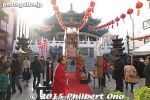
63 views
|
|

Entrance to the special exhibition room.62 views
|
|
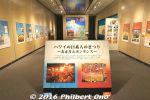
Medium-size exhibition room for the "Hawai’i's Nikkeijin Matsuri—Oshogatsu and Bon Dance" (ハワイの日系人のまつり -お正月とボンダンス-) exhibition.62 viewsUnfortunately, the exhibition has no English explanations so I've created a quick translation of all the panel displays on this web page. (It's not an official translation nor a word-for-word translation, but still very accurate.)
|
|

Bon Dance Panel 3 - The Resurrection of Bon Dance After the War62 viewsWhen the Pacific War broke out, cultural activities by the Japanese immigrants were banned. No more bon dances.
It wasn't until the summer of 1947 when a bon dance was finally held again. It was a fundraiser for a war memorial.
In 1948, bon dances saw a full-fledged ressurrection. In 1951, the biggest bon dance was not at a Buddhist temple, but at Ala Moana Park in Honolulu. It was held jointly by nisei veterans clubs (100th Infantry Battalion Veterans, 442nd Veterans Club, MIS Veterans Club, and 1399th Veterans Club). The postwar bon dances were held to memorialize the war dead.
Panel photo: Top photo is a July 1947 Hawai’i Hochi newspaper ad for a bon dance to raise funds to build a memorial. Bottom photo is a Hawai’i Hochi newspaper article about the 1951 bon dance held jointly by nisei veterans clubs. Headline says there were 2,000 dancers and 30,000 spectators.
|
|

Large showcase displaying Iwakuni Ondo implements and nisei soldier artifacts.62 views
|
|
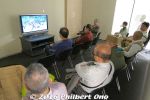
The back of the exhibition room has this small viewing room for video screenings of "Great Grandfather's Drum" about Maui Taiko (led by Kay Fukumoto) and a condensed documentary video by Jun'ichi Suzuki about the nisei vets.62 views"Great Grandfather's Drum" (57 min.) is screened every day of the exhibition at 10 am and 2 pm. Suzuki's film (40 min.) is shown every day at 11:30 am and 3 pm. Suzuki will also give a one-hour talk at the museum on Jan. 14 at 2 pm. Free admission, no reservations required.
|
|
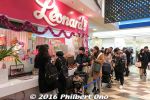
After seeing the exhibition, you might want to stop by the neighboring Yokohama World Porters shopping mall and get a malasada from Leonard's in the Hawaiian Town section.62 viewsIt might be crowded though, especially on weekends/holidays.
|
|
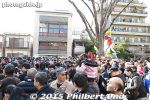
62 views
|
|
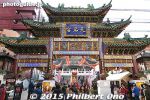
Yokohama Ma Zhu Miao Temple (Masobyo in Japanese 横浜媽祖廟) was built in 2006 to mark the 150th anniversary of Yokohama Port opening to foreign trade.62 views
|
|
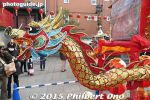
Dragon62 views
|
|
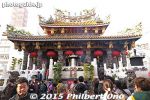
Yokohama Chinatown's main temple called Kwan Tai Temple (Kanteibyo in Japanese 関帝廟). Busy with Chinese New Year worshippers. Dedicated to Kwan Tei, a famous general in the ancient Chinese Imperial army and Taoist symbol of integrity and loyalty62 views
|
|
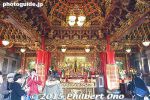
Inside Yokohama Chinatown's main temple called Kwan Tai Temple (Kanteibyo in Japanese 関帝廟).62 views
|
|

Bon Dance Panel 1 - The Japanese in Hawai’i61 viewsHow did the Japanese culture and lifestyle continue in Hawai’i up to today?
The Japanese was originally the largest ethnic group, accounting for over 40% of Hawai’i's population. This percentage began to shrink from the 1930s with the influx of other ethnic groups. By Dec. 1941, they still accounted for 37% of Hawai’i's population. According to the 2000 US Census, they comprised 20% of Hawai’i's population. Today, they are still a major ethnic group in Hawai’i.
By the early 1900s, as much as 70% of sugar plantation laborers were Japanese immigrants. Hawai’i's sugar industry saw explosive growth as it catered to the world market. There was a major labor shortage so they brought in cheap laborers from overseas starting with the Chinese. Later Japan and the Kingdom of Hawai’i signed the Kanyaku Imin agreement which allowed Japanese to emigrate to Hawai’i from 1885.
The early immigrants who worked on the sugar plantations as contract laborers had planned to make money in Hawai’i and return to Japan as rich men. They did not intend to live in Hawai’i permanently. The early Japanese immigrants lived together in their own plantation camps. People from the same hometown or prefecture would form an association and help each other. This lifestyle contributed to the transference of Japanese New Year's traditions and the bon dance to Hawai’i.
Panel photo: 1885 Kanyaku Imin contract for an immigrant named Otsuki.
|
|

Top photo is some of the soldiers in the 100th Infantry Battalion at Camp McCoy in Wisconsin.61 viewsBottom photo are 100th Infantry Battalion soldiers taking a short break in Menton, France in 1944.
|
|
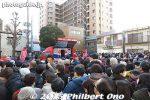
61 views
|
|
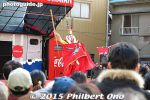
61 views
|
|
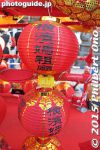
61 views
|
|
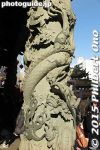
Carved pillar61 views
|
|
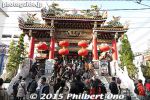
Yokohama Chinatown's main temple called Kwan Tai Temple (Kanteibyo in Japanese 関帝廟). Busy with Chinese New Year worshippers. 61 views
|
|
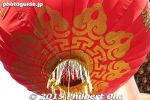
61 views
|
|
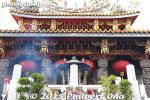
61 views
|
|
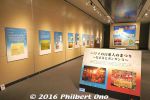
The left wall has exhibit panels explaining about bon dance in Hawai’i.60 views
|
|

Oshogatsu Panel 1 - History of Japanese New Year's in Hawai’i60 viewsBefore WWII, the Japanese immigrants (mostly sugar plantation workers) were free to practice their own culture and religion so they celebrated Oshogatsu and other traditional Japanese holidays. However, the war changed all that as the Japanese immigrants were viewed as associates of the enemy. Japanese community leaders were arrested and detained. Japanese language schools, Buddhist temples, and Shinto shrines were shut down and dissolved. Using the Japanese language in public was banned, and gatherings of 10 or more Japanese people were prohibited. Therefore, the Japanese immigrants could no longer hold their festivals like Oshogatsu.
However, after the war, these restrictions were lifted and Japanese immigrants could again celebrate New Year's by visiting temples and shrines, pounding mochi, etc. We can see how their New Year's traditions developed in Hawai’i.
Panel photos: Upper left photo is Hawai’i Daijingu Shrine in Honolulu during New Year's, upper right is mochi pounding at Kahului Hongwanji on Maui, lower left is New Year's decorations at a Japanese American's home (Stephanie Ohigashi), lower right is a family at home having ozoni soup for New Year's (Stephanie Ohigashi).
|
|

Corner dedicated to nisei soldiers.60 views
|
|

Military medals, badges, and patches from Saburo Ishitani of the 100th Infantry Battalion.60 views
|
|
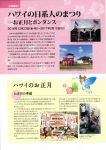
Page 2 of the newsletter gives an overview of the exhibition. Lower article describes New Year's preparations in Hawai’i.60 views
|
|
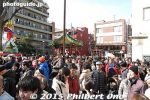
60 views
|
|
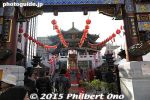
60 views
|
|
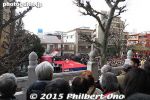
60 views
|
|
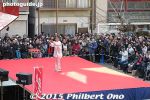
60 views
|
|
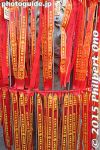
60 views
|
|
| 797 files on 4 page(s) |
 |
3 |
|